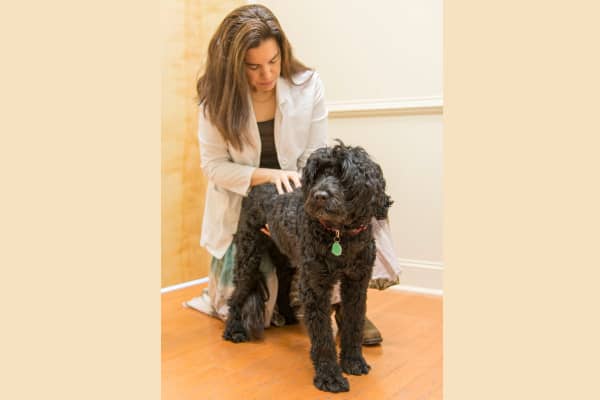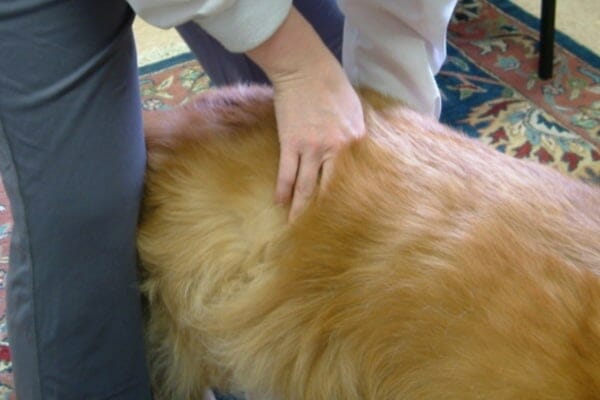How do you treat spondylosis in dogs?
If your dog has spondylosis but isn’t experiencing pain or discomfort, he may not need treatment right away…or ever. But if your veterinarian shares my thinking, he or she may recommend joint supplements because they have a protective effect on joints.
Ingredients like glucosamine and chondroitin help keep joints flexible and healthy. Therefore, supplements may be helpful in slowing the development of spondylosis. And although I believe that the best supplement for joint pain in dogs is not just about joints, my go-to product recommendation for protecting the health of the joints between the vertebrae is Encore Mobility™ with Green Lipped Mussel and New Zealand Deer Velvet. In very rare cases, surgery may be necessary to remove spurs that are pressing upon the spinal cord, but I’ve never seen this scenario in my entire career.

If your senior dog is experiencing back pain, it’s most likely not coming from spondylosis. Anything’s possible, but there’s a laundry list of conditions that I’d be concerned about before pinning the pain on spondylosis. But whatever the root cause, your dog may benefit from anti-inflammatory medications and/or medications for nerve pain. These are often able to provide relief for back pain. Also, veterinary acupuncture, animal chiropractic, and physical therapy are highly effective methods for mitigating pain and improving mobility for these dogs.

If your dog is overweight, this is the #1 thing you must address to protect your dog’s spine. Your veterinarian can help you formulate a personalized diet plan. Lower calorie foods and controlled exercise can facilitate weight loss. If you’re unsure whether your dog is overweight, you’ll want to “find your dog’s number” on our canine body condition score chart. Since present-day pups live longer than their predecessors, they’re more susceptible to joint damage and inflammation over time. Joint inflammation is commonly known as canine arthritis. Spondylosis has been likened to arthritis in the spine. However, unlike arthritis, there is not an inflammatory component with the bony changes. This is a blessing because inflammation means hurting.
Is spondylosis deformans more common in certain breeds of dogs?
Although this condition was once thought to be more common in large breed dogs, any middle-aged to older dog can be affected. In most dogs, this degenerative condition will begin to develop by 10 years of age, and some researchers feel that every dog will develop this condition if it lives long enough.
Causes of Dog Spine Problems
The most common cause of spinal problems in dogs is trauma.
The trauma can be caused by a fall or an accident, although the more common causes include everyday activities like jumping for balls and terrible posture.
Spinal cord injuries mainly occur as a result of a spinal dislocation or fraction.
However, the injury doesn’t have to be recent. The origin of the spinal problem can happen years before symptoms show up.
Symptoms of spinal trauma in the dog usually show up suddenly and can be severe and worsen progressively.
There is no single way to prevent any kind of injuries in dogs. Keep your pup safe from traffic and cars since car accidents are one of the leading causes of injuries in dogs whenever playing or training with your dog, practice safety and be cautious.
Other than that, ensure that your pup has the correct posture and doesn’t work him too hard during exercise or play.
Sometimes dogs do not realize when theyre overworked, and youll have to do this guesswork for them.
If you notice that your canine is limping or shows any other signs of spinal problems, take him to the vet immediately.
Your vet will notice any fractures or dislocations on x-rays or CT scans if the pets problems are caused by trauma or injury.
The most common way to treat traumas in dogs is with pain medication and proper rest. However, some types of injuries require surgery.
Dog spinal disc problems: the initial consult
Have you heard of spondylosis deformans? This condition affects the spine of older dogs and causes the bones (vertebrae) of the back to fuse together.
And if you are glazing over already, keep reading: Experts believe every dog who lives long enough will eventually develop this condition.
The spine is made up of 30 small bones called vertebrae — plus a variable number of tail vertebrae. These are separated from one another by discs and joined together flexibly with ligaments. This clever system allows the spine to bend and flex rather than exist ramrod-straight like a broom handle.
Over time, those shock-absorbing discs start to show signs of wear and tear (a bit like brake discs in a car wearing out). This makes bending and stretching painful, and more serious than that, it leads to instability, which could put pressure on the spinal cord.
We sometimes lose sight of just how clever the body is, and this is one of those times. To stabilize the spine and provide a natural brace, the vertebrae grow bony spurs that reach out to one another, like the hands of acrobats on the high trapeze, and join together to form a bony bridge. It is this bony bridge linking vertebrae together that is the condition called spondylosis deformans.
Spondylosis used to be considered a condition mainly affecting large dogs, but we now know that any dog can be affected. However, genetics come into play with predisposed boxers, Airedale Terriers and German Shepherds, but that’s balanced against age.
I’ve seen dogs ranging from Cairn Terriers to Labrador crosses and Great Danes who had particularly dramatic-looking fused spines on X-ray.
Spondylosis develops in response to degeneration of the backbone, and so the signs are related to back pain. You are most likely to notice your dog is stiff and perhaps has difficulty stretching, jumping up or putting his head down to a food bowl.
Some dogs become hyperasethetic, which means oversensitive to pain. These dogs yelp piteously before you touch them, or they move slightly and scream as if someone had trapped their paw in a door. Their response is out of proportion to the action because pinched nerves amplify the pain.
To understand this, think of the pain as a noise and how it sounds with the naked ear as compared to what it sounds like through headphones with the volume turned up to the max.
Spondylosis is often picked up as an incidental finding when the dog is radiographed for another problem. The reason it’s an “incidental” is that spondylosis is painful only if it pinches nerve roots. The rest of the time, it’s doing a useful job of supporting the backbone (like scaffolding).
Spondylosis can look dramatic on X-ray and yet not cause pain, so don’t be depressed if your veterinarian shows you some impressive-looking arthritic lesions of the spine. However, it may be necessary to run further tests (MRI scan or myelography) to check if the decayed discs are pressing on the spinal cord or the extra bone has trapped nerve roots (both of which can be painful).
This happy Doberman got a second chance at life after abandonment and a diagnosis of spondylosis deformans:
Usually no action is necessary other than pain relief (a catch-all because the dog probably also has arthritis in other joints as well). Again, if nerve roots are being pinched, then special painkillers, such as gabapentin, that ease nerve-generated discomfort may be prescribed.
As a rule of thumb, surgery to de-bulk the extra bone is not recommended. This not only weakens the spine but also is a fool’s errand because the bone is liable to grow back again.
Spondylosis and spondylitis may share 7 of their 11 letters, but it’s those final 4 letters that are important. The “-itis” part of spondylitis means “inflammation”; in this case, the inflammation is caused by a blood-borne infection that gets into the bones of the spine.
Whereas spondylosis is largely painless, a dog with spondylitis is unwell, feverish and in a lot of pain. The treatment is also very different, requiring weeks of strong antibiotics and pain relief. However, the good news is spondylitis is rare, so your dog is much more likely to get spondylosis rather than a more serious disease.
This pet health content was written by a veterinarian, Dr. Pippa Elliott, BVMS, MRCVS. It was last reviewed Oct. 13, 2018.